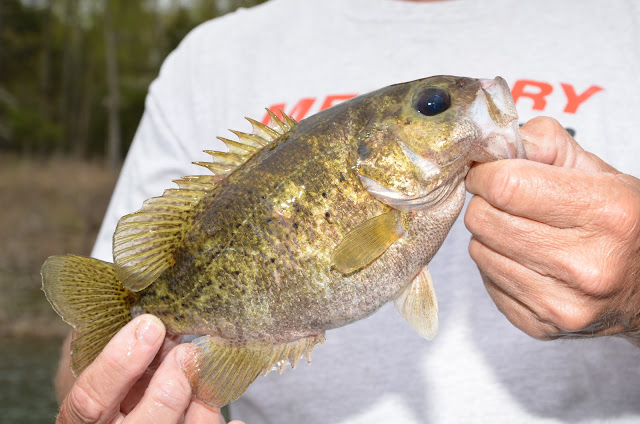The first thing you need to catch a big flathead catfish is a nice farm pond full of “perch”. Well, actually they aren’t perch. They are sunfish, of one kind or another. “Perch” is a term the old timers in the pool hall gave to all types of panfish in the Ozarks, and it has been too difficult for me to stop calling them that. Perch in the Ozarks are most often green sunfish or long-eared sunfish or perhaps small bluegill.
Sunfish…when you get good big ones, they are very good to eat. In Ozark streams, green sunfish can get very hefty, and so can bluegills in our farm ponds and large Ozark reservoirs. But most of the time, in a farm pond, or along the shallow water of a reservoir, you will catch those species just too small to eat. So you convert them to catfish by using them as bait. The spectacularly colored long-ear sunfish, also known as a ‘punkin-seed’ to many, seldom reaches an edible size, but they are great catfish bait. And sometimes in farm ponds around the Ozarks you will find hybridized sunfish, half of one species and half of another.
It doesn’t matter, a flathead catfish wants live bait, if not night crawlers and any of those little sunfish will do. It should be pointed out that we spent hours and hours on the river seining bait that was just as good as sunfish. If we could get suckers that were up to 12 inches long, grandpa was tickled pink. A sucker that is 12 to 15 inches long is a great meal for a 30 or 40 or 50 pound flathead. Just as good were the horny-head chubs, often 12 or 10 inches long and what we call ‘doughgut minnows’, which you could seine below swift shoals.
So to catch a big flathead, you first have to find a place where you can catch a hundred or so live sunfish, chubs and big minnows and then you head to the river or lake, where you set a trotline in water where the flathead, also known as yellow catfish, would be found. They like a little deeper water this time of year, around big bluffs, where there are huge underwater boulders or submerged logs of substantial size. You learn in time, what to look for. Flatheads come in all sizes of course, but if you set a trotline, you are hoping for something between 20 and 50 pounds, and aware that on occasion Ozark fishermen catch them up to 70 or 80 pounds. That’s a tremendous fish.
In lakes throughout the Ozarks, there are also channel catfish, which can reach sizes up to 20 or 25 pounds, but normally are less than10. The blue catfish is more similar to a channel cat than a flathead, but different in many ways, the main ways being the size to which he can grow. Blue catfish too, can be taken up to 70 or 80 pounds, record flathead and blues both exceed 100 pounds. Both blues and channel cat will take the live sunfish, but they are also taken on nightcrawlers, dead shad, chicken livers, and prepared “stinkbaits”. But, for any of the three species I prefer the sunfish. And besides, if you have youngsters or grandchildren, they’ll love helping to catch the bait. There’s nothing wrong with going to a farm pond or creek and doing some “perch-jerking” as it is so often called by old-time Ozarkians like me.
I have been after catfish a whole lifetime, guided as a youth by my grandfather and those old timers in the pool hall who reckoned that though trotlining was a lot of work it was worth doing.
It only takes one 30 or 40 pound flathead to feed a lot people, and that’s what I am going after. But I often am happy with a 20-pounder. I set trotlines for flatheads with rock weights about the size of a man’s fish, one every five hooks along that line. You need big hooks for flathead or blues, size 4-0. While the 6-0 is plenty big enough for the channel cat, why use them when you might hook a huge blue or flathead. Stay with the bigger hooks and you won’t be sorry. Be sure the hook-lines, called stagions, off the main lines, are between 15 and 20 inches in length, and don’t use snaps. Loop them on, and be sure there are knots in the main line so hooks and stagions won’t slide.
But that weighted line is dangerous. Should you become entangled in it, or hooked, it can pull you under, even if you have a life jacket on. Grandpa and Dad taught me when I was very young that it was mandatory to wear a sharp knife in a sheath for that very possibility. You need to be able to cut yourself free in a hurry. Two sheathed knives on your belt won’t hurt.
Remember if you set trotlines, you are only allowed a limited number of hooks depending on what state you are in and they must be spaced three feet apart to be legal. And remember that on one end, you must have a tag of some kind, (I use a flat piece of wood) with name and address on it, and your fishing license number if you have one.













